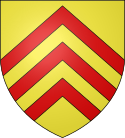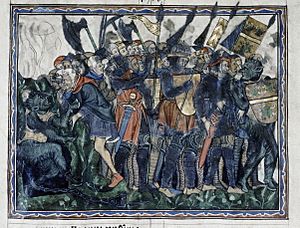Gilbert de Clare, 7th Earl of Gloucester facts for kids
Quick facts for kids
Gilbert de Clare
|
|
|---|---|
| Earl of Hertford Earl of Gloucester Lord of Glamorgan |
|

Coat of Arms of Clare family
|
|
| Tenure | 1262–1295 |
| Predecessor | Richard de Clare, 5th Earl of Hertford |
| Successor | Gilbert de Clare, 7th Earl of Hertford |
| Other titles | 9th Lord of Clare 9th Lord of Tonbridge 8th Lord of Cardigan |
| Born | 2 September 1243 Christchurch, Hampshire |
| Died | 7 December 1295 (aged 52) Monmouth Castle |
| Buried | Tewkesbury Abbey 51°59′25″N 2°09′37″W / 51.9903°N 2.1604°W |
| Nationality | English |
| Wars and battles | Second Barons' War Welsh war of 1282 |
| Spouse(s) | Alice de Lusignan of Angoulême Joan of Acre |
| Issue | Isabella de Clare Joan de Clare Gilbert de Clare Eleanor de Clare Margaret de Clare Elizabeth de Clare |
| Parents | Richard de Clare Maud de Lacy |
Gilbert de Clare (born September 2, 1243 – died December 7, 1295) was a very powerful English noble. He was known as "Red" Gilbert or "The Red Earl." People think this was either because of his hair color or his fiery personality in battles! He held important titles like the Earl of Hertford and Earl of Gloucester. He also controlled the Lordship of Glamorgan in Wales, which was one of the richest areas ruled by a Marcher Lord. Marcher Lords were powerful nobles who guarded the border between England and Wales. Gilbert also owned over 200 estates in England.
Contents
Early Life and Family
Gilbert de Clare was born in Christchurch, Hampshire. His father was Richard de Clare, who was also an Earl. His mother was Maud de Lacy. When Gilbert's father passed away in 1262, Gilbert was still quite young. He inherited all of his father's lands and titles, including Lord of Glamorgan, starting in 1263. Because he was underage, a noble named Humphrey de Bohun, 2nd Earl of Hereford became his guardian.
The Barons' War and Key Battles
Gilbert de Clare played a big part in the Second Barons' War. This was a conflict between King Henry III and a group of powerful nobles led by Simon de Montfort.
Fighting at Lewes
Before the famous Battle of Lewes in May 1264, Simon de Montfort made Gilbert and his brother Thomas knights. Gilbert led the central part of the barons' army. During the battle, King Henry III and the Earl of Cornwall were forced to retreat. Gilbert accepted the surrender of the Earl of Cornwall. After this victory, Montfort and Gilbert became very powerful, with Montfort basically ruling England.
Changing Sides
Later in 1264, Gilbert and his allies were temporarily removed from the church (called "excommunicated") by the Pope. They were also declared rebels. However, Gilbert soon had a disagreement with Montfort. To stop Montfort from escaping, Gilbert destroyed ships at Bristol and a bridge at Gloucester. He then switched his support to Prince Edward, the King's son. Gilbert helped Prince Edward win at Kenilworth and played a major role in the Battle of Evesham in August 1265. In this battle, Montfort was killed, and the King's side won.
Life as a Marcher Lord
After supporting Prince Edward, Gilbert was rewarded with important castles and lands, including Abergavenny and Brecknock. He also started building the strong Caerphilly Castle. In October 1265, he was welcomed back into the church and pardoned by the King for his earlier actions.
Protecting Welsh Lands
In 1268, Gilbert refused to attend Parliament because he said his lands in Wales needed his attention. The Welsh leader, Llewelyn the Last, was often attacking the border areas. When King Henry III died in 1272, Gilbert was one of the first nobles to promise loyalty to the new King, Edward I. Edward was away on a Crusade at the time. Gilbert helped make sure that Edward's son would immediately become King, which was a new idea at the time. Gilbert then served as a joint guardian of England until King Edward returned in 1274.
The Welsh War of 1282
During King Edward I's invasion of Wales in 1282, Gilbert de Clare wanted to lead an attack into southern Wales. King Edward made him the commander of the southern army. However, Gilbert's army suffered a big defeat at the Battle of Llandeilo Fawr. After this loss, King Edward replaced Gilbert as commander.
A Dispute with Another Noble
In 1291, Gilbert had a big argument with another powerful noble, the Earl of Hereford, about land in Brecknock. This argument turned into a small private war between them! Even though Marcher Lords sometimes fought private wars, King Edward I stepped in. He had both Gilbert and the Earl of Hereford arrested. They were both fined a lot of money, and their lands were taken away for a short time. This was a public lesson from the King, showing everyone that his authority was supreme.
Marriages and Children
Gilbert de Clare was married twice.
First Marriage
His first wife was Alice de Lusignan. They married in 1253 when Gilbert was only ten years old. Alice was a niece of King Henry III. Gilbert and Alice separated in 1267. They had two daughters:
- Isabel de Clare (born 1262 – died 1333). She married Maurice de Berkeley, 2nd Baron Berkeley.
- Joan de Clare (born 1264 – died after 1302). She married Duncan Macduff, 7th Earl of Fife and later Gervase Avenel.
Second Marriage
After his first marriage ended, Gilbert married Joan of Acre in 1290. Joan was the daughter of King Edward I of England! King Edward wanted to connect Gilbert and his vast lands more closely to the Crown through this marriage. The marriage contract said that their lands would only be inherited by their direct children.
Gilbert and Joan had one son and three daughters:
- Gilbert, Earl of Hertford and Gloucester (born 1291 – died 1314). He inherited his father's titles but was killed at the Battle of Bannockburn.
- Eleanor de Clare (born 1292 – died 1337). She married Hugh Despenser the Younger, a favorite of her uncle King Edward II.
- Margaret de Clare (born 1293 – died 1342). She married Piers Gaveston, another favorite of King Edward II.
- Elizabeth de Clare (born 1295 – died 1360). She married three times and had one child from each marriage.
Death and Resting Place
Gilbert de Clare passed away at Monmouth Castle on December 7, 1295. He was buried at Tewkesbury Abbey, next to his grandfather, another Gilbert de Clare. His wife, Joan of Acre, managed his large estates until her own death in 1307.
|


